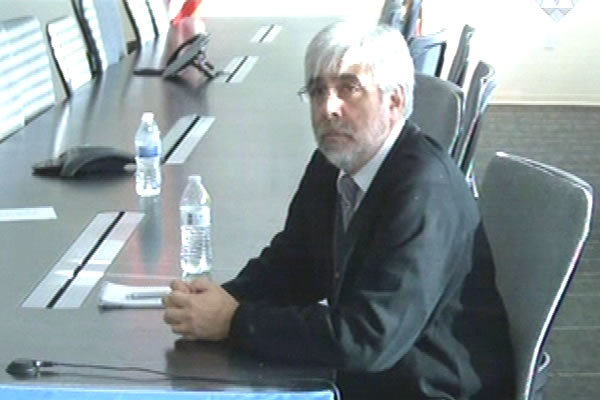Home
CONTESTING REPORTS ON SREBRENICA EXHUMATIONS
Ratko Mladic’s defense has called David del Pino, a forensic expert from Chile, in a bid to contest the findings from the report produced by the prosecution forensic expert William Haglund on the exhumations of Srebrenica mass graves. The defense has relied on a report by the Supervisory Commission from San Antonio, but as the report concluded that the errors made by Haglund did not in any way compromise the scientific value of his findings, the defense has thus failed to achieve the desired effect
 David del Pino, defence witness at Rako Mladic trial
David del Pino, defence witness at Rako Mladic trial A forensic anthropologist from Chile, David del Pino, testified at the trial of Ratko Mladic via video link from the USA. In 1996, del Pino was a member of the forensic team put together by the Physicians for human rights and he participated in the exhumation of several mass graves that contained the Srebrenica victims. Through del Pino’s testimony, the defense intended to contest, or at least diminish, the importance of the findings related to the exhumations coordinated and led by anthropologist William Haglund.
Mladic’s defense counsel Dragan Ivetic referred to a report produced by the Supervisory Commission from San Antonio, which had been charged with checking the criticism against methods Haglund had applied. The defense counsel quoted del Pino who stated in the report that the clothes found in one of the graves were discarded on Haglund's orders. Del Pino noted in the report that Haglund was often absent and that he spent too much time with the media.
Del Pino argued that the clothes from the grave should have been examined because there might have been some identity papers inside. Del Pino didn’t know if someone else had verified whether the clothes contained any documents or other evidence. Haglund’s absence ‘slowed down’ the exhumations, Del Pino noted. It was Del Pino's impression that Haglund spent too much time with journalists, and in fact, he rushed the exhumations to keep the press happy.
In the cross-examination, prosecutor Peter McCloskey highlighted Haglund’s conclusions about the exhumation of the Branjevo mass grave. At least 132 bodies were recovered from the mass grave. Eighty-two of the victims had their hands tied and were blindfolded. The investigation showed that the mass grave was related to five secondary graves, the prosecutor noted. In those mass graves 1,611 bodies were identified using DNA analysis. According to the evidence of Drazen Erdemovic, who confessed to having participated in the execution, about 1,200 Bosniaks were killed on 16 July 1995 in Branjevo. That same day, according to Erdemovic, about 500 Muslims were executed in Pilica, the prosecutor recalled.
Del Pino confirmed that the exhumation of the Branjevo grave was very accurate and professional. It was possible to link primary and secondary graves using DNA analysis, del Pino confirmed.
In a reply to Judge Orie's question, the witness said that Haglund’s frequent absences caused some problems in terms of coordination but didn’t impact the final results and conclusions. The time Haglund spent with the media likewise did not affect the final outcome, del Pino confirmed. As for the quantity of discarded clothes, del Pino said they could fit be in a 40 by 30 cm box.
Finally, Judge Moloto referred to the conclusion of the Supervisory Commission's report that the defense counsel had failed to quote. The Commission concluded that Haglund's failings did not compromise the scientific value of his findings related to the mass grave exhumations. Del Pino agreed with that conclusion.
Ratko Mladic’s trial continues on Monday, 7 December 2015.
Linked Reports
- Case : Mladic
- 2015-12-01 DIFFICULTIES UNDERSTANDING CRIMINAL PROCEEDINGS
- 2015-12-01 HOW WITNESSES IN VOJISLAV SESELJ’S CASE WERE MADE TO ‘CHANGE THEIR MINDS’
- 2015-11-30 HISTORIAN CORRECTS GRAMMAR
- 2015-12-07 FROM ISLAMIC DECLARATION TO ISLAMIC STATE
- 2015-12-08 DODIK: SDS PARTY LEADERSHIP INVOLVED IN WAR CRIMES
- 2015-12-09 LISBON AGREEMENT – CHANCE FOR PEACE OR PLAN TO DESTROY BOSNIA?
